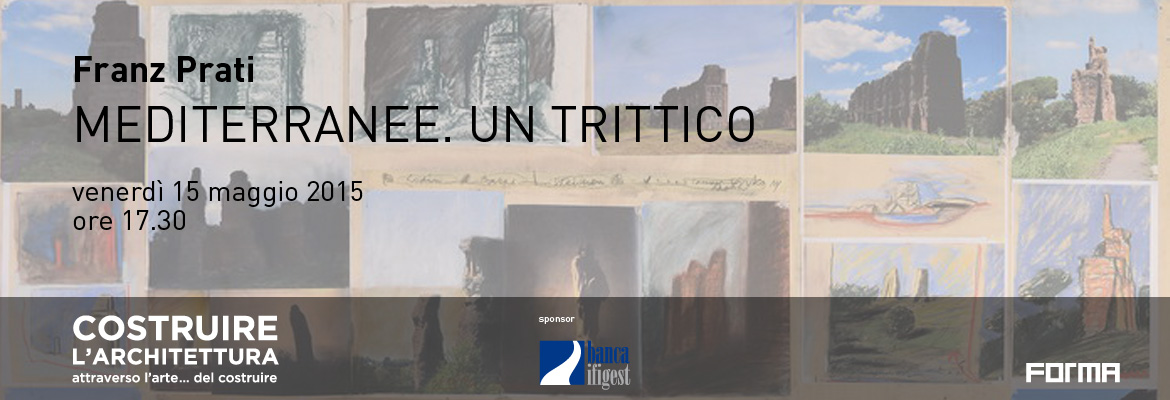Venerdì – 15 mag 2015 – ore 17.30
Costruire l’architettura: “Mediterranee. Un trittico”
Franz Prati
Ricordate il platonico mito della caverna? Ciò che gli uomini sperimentano, come prigionieri incatenati piedi e testa, impossibilitati a voltarsi e alzarsi, sono solo ombre, proiezione delle cose reali alle loro spalle, fuori dalla caverna, illuminate da potentissima luce, eterna origine di tutto. Liberare il prigioniero dalle catene, convertirlo alla verità delle cose aldilà delle loro ombre, condurne la mente a vedere l’originario, l’Arché, è compito della filosofia.
Senonché, due millenni e mezzo di filosofare hanno messo in luce l’impossibilità di ogni archè (dunque anche del senso originario alla radice della parola “architettura”), ossia di ogni creazione e distruzione che abbia una causa ultima fuori dal tempo, fuori dalla “caverna” platonica.
Alla luce del pensiero contemporaneo, «l’archeologia del presente», tema centrale dell’affascinante incontro con Franz Prati, la si può intendere come ciò che resta dell’antico senso dell’archè e insieme della sua caduta, un grandioso rudere. Siamo immersi in un «paesaggio di frammenti», resti, tracce del passato. Un passato che adesso non ha più il senso ultimo dell’eterno, interamente dato una volta per tutte, unificazione negante ogni frammentazione, ma quello dell’umana produzione e della sua casualità. La “caverna”, ciò che sperimentiamo e siamo capaci di creare, è l’unica realtà, niente sta alle spalle.
Tuttavia, centrale nella poetica di Franz Prati è l’immagine dello «scoglio». Ricorre in ogni opera come fosse il suo scoglio. È ciò in cui ci s’incaglia, insormontabile, inflessibile, come l’Arché, non è prodotto ed è immodificabile. Dà il senso proprio del residuo dell’antico in cui ci s’imbatte nel presente. Il passato, infatti, anche quando pensato solo come prodotto (e non un eterno archè) essendo ciò che non è più, risulta immodificabile: non si può agire su ciò che non esiste più. Non solo. Si presenta, insieme, come sviluppo, concatenazione di cause da cui finisce per dipendere totalmente il presente, negando la nostra evidente capacità creativa. È questa una delle più intricanti situazioni aporetiche del pensiero contemporaneo pur liberato dal senso antico degli immutabili.
Ma dall’altro lato viene in luce che le cose presenti siano traccia di un determinato passato è un’interpretazione, una nostra produzione, una poiesis. Nelle esplorazioni che compie nel «paesaggio di frammenti», nella sua ricerca della «archeologia del presente», Franz Prati si fa – non a caso – accompagnare da «viaggiatori poeti». Riconoscere che i resti dell’antico siano «scogli» e insieme cose vive e presenti, tanto da apparire prima scultura di figure umane e poi veri e propri personaggi che animano lo scenario in cui viviamo, è già un dominare lo scoglio, un farlo protagonista di progettualità, e dunque un convertirne l’apparente inflessibilità nel suo opposto.
Francesco Ventura
Friday – may 15th 2015 – 17.30 pm
Building the architecture: “Mediterranean triptych”
Franz Prati
Remember Plato’s myth of the cave? What humans perceive, as prisoners with their feet and head chained, unable to turn around or get up, are only shadows, the projection of the real things behind them, outside of the cave, lit by a powerful light — the eternal source of everything. The duty of philosophy is to free prisoners from their chains, turning them to the truth of things beyond their shadows, leading their mind to see the origin, the Arché.
Nonetheless, two and half thousand years of philosophizing have brought to light the impossibility of any Arché (including in the original meaning of the root of the word “architecture”), i.e. every creation and destruction that has an ultimate cause outside of time, outside of Plato’s “cave.”
In light of contemporary thought, the “archeology of the present,” was the focus of Franz Prati’s fascinating talk, showing how that which is left of the old meaning of Archè as well as its collapse, is a magnificent ruin. We are immersed in a “landscape of fragments,” remnants, traces of the past. The past no longer has the ultimate meaning of the eternal, given fully once and for all, unification against all fragmentation. Instead it is a past of human production and its randomness. The “cave” — that which we perceive and we are able to create, is the only reality — there is nothing behind us.
Nonetheless, the image of the “cliff” is central to Franz Prati’s poetics. It recurs in every work as if it where his stumbling block. This is the thing on which we run aground, insurmountable, inflexible, and like Arché, it is not produced and unchangeable. It gives the sense of that which is left of the old and which we come against in the present. The past — even when considered only as a product (rather than an eternal Archè) — because it is that which no longer is, is unchangeable; we cannot act on what no longer exists. And beyond that, it also presents itself as a development, a chain of causes from which the present depends completely, denying our evident creative capacity. This is among the most confounding, impassable situations in contemporary thought, though free from the old sense of being immutable.
Yet, on the other hand, it brings to light that present things are traces of a specific past, an interpretation, something we produced, a poesis. In Franz Prati’s explorations in the “landscape of fragments,” in his study of the archeology of the present,” he — not incidentally — takes along “poetic travelers.” Recognizing that what is left of the old are “stumbling blocks” as well as living, present things, seeming first to be sculptures of human figures and then real characters that enliven the settings of our lives, means already having surpassed the block and made it a key part of the design approach, and therefore convert its apparent inflexibility into its opposite.
Francesco Ventura
